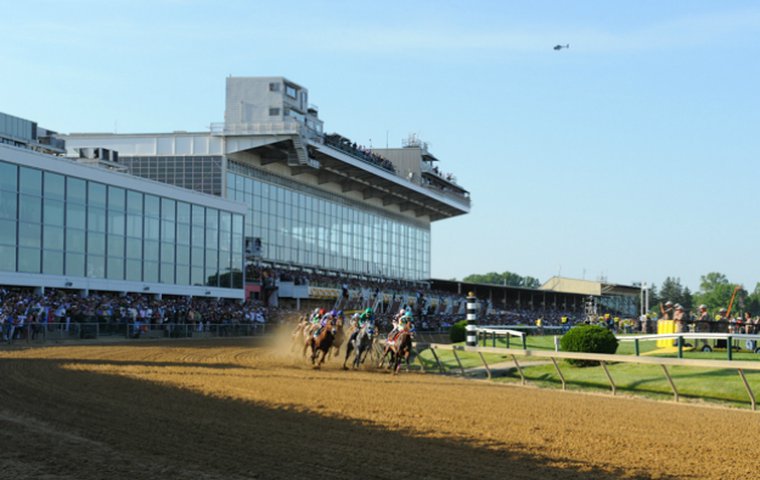
The field for the 140th Preakness is set, and the octet that will go postward includes five runners from the Kentucky Derby. Despite the quick turnaround from the first to the second jewels of the Triple Crown, horsemen are generally more willing to eschew regular methodology and test their runners despite the abbreviated rest. Those five Kentucky Derby alums possess a major edge on their competition, as historical data suggests the “new shooters” enter at a major disadvantage.
The lack of activity among major horses is a much ballyhooed topic in American Thoroughbred racing. A “campaign” nowadays regularly consists of four to five races with breaks in between of no fewer than 45 days. The Preakness marks the brief period every year when this approach is frequently ignored by even its staunchest advocates, and the effect of short rest on returning Derby runners makes for interesting study.
Eight of the last nine trifecta finishers in the Preakness Stakes were returning after racing in the Kentucky Derby. In the 2014 edition, heavy favorite California Chrome took his roadshow to Pimlico and gamely held off Ride on Curlin in the final strides. Both of those runners had contested the Kentucky Derby, and each had busy winter and spring campaigns. The distant third-place finisher, Social Inclusion, had not run since the Wood Memorial, but was also beaten by eight lengths in the Preakness Stakes. Last year’s Preakness also stretched the streak to six straight editions where at least two trifecta finishers had raced in the Kentucky Derby. Additionally, only two of the last 14 Preakness winners had not raced in that year’s Kentucky Derby.
The two exceptions during that 14-year stretch were Eclipse Award winner Bernardini (2006) and Horse of the Year Rachel Alexandra (2009). What those two champions shared was relatively short rest in the time leading up to their respective triumphs. Bernardini had run 21 days before in the Withers Stakes at Aqueduct, while Rachel Alexandra exited a Kentucky Oaks score 15 days earlier where a football field was left between she and her rivals at the finish line. Her victory over males in the Preakness was perhaps her greatest accomplishment during a campaign for the ages in 2009. Since 1980, only two horses have won the Preakness off of more than 21 days’ rest – Codex (1980) and Red Bullet (2000).
The three runners in this year’s field that did not race in the Kentucky Derby are Federico Tesio winner Bodhisattva, Lexington winner Divining Rod, and recent maiden winner Tale of Verve. The first two in that trio were pointed to the Preakness immediately after their most recent victories. Tale of Verve ended up on the Also Eligible list for the Kentucky Derby and was re-routed to the Preakness when he failed to gain entry at Churchill Downs. While Bodhisattva has the advantage of a local victory, he and Tale of Verve will need major improvement to achieve even minor placings in the Preakness Stakes. Divining Rod has graded stakes seasoning, as he was third in the Tampa Bay Derby before winning the aforementioned Lexington. He is the most talented of the non-Derby participants and has upside given that he is so lightly raced.
In addition to their poor record winning the Preakness, non-Kentucky Derby participants have had limited success even finishing in the money. Those that entered the Preakness off of layoffs longer than 21 days have greatly struggled. Rachel Alexandra and Bernardini each entered their respective Preakness victories with races in the three preceding weeks. There have been a total of 76 starters in the last 14 runnings of the Preakness that entered off of layoffs longer than 21 days. Only 12 of those runners have finished in the money, and they are 0-76 in terms of earning top honors.
What can explain this phenomenon of Kentucky Derby participants running well in the Preakness? Given how lightly raced horses are in modern times, they are rarely tested with quick returns to the racetrack. In recent years, many of the runners who performed particularly well in the Kentucky Derby had run sparingly prior to that event. That left them as lightly raced and fresher horses when they arrived for the Preakness. This year’s 1-2 finishers in the Kentucky Derby are great examples of the phenomenon - both American Pharoah and Firing Line had run only twice before their trips to Churchill Downs. Bob Baffert has run 29 horses in the last five years off of 14 days of rest, and 9 of them have visited the winner’s circle. One of those victories was earned by Lookin At Lucky in the 2010 Preakness, as he came back two weeks after the Kentucky Derby and earned redemption for a troubled trip.
American Pharoah will bid to become the seventh horses in the last 14 years to win the Preakness after taking the Kentucky Derby. He lacks the foundation of some of the prior Triple Crown aspirants, but was lightly raced earlier this year by design. Bob Baffert has previously won the Kentucky Derby three times, and each of those runners came right back to win the Preakness (Silver Charm in1997, Real Quiet in 1998, and War Emblem in 2002). There is no doubt that he knows how to condition horses to withstand the rigors of the Triple Crown. All reports about his training after the Kentucky Derby were positive, as he galloped during the week before shipping to Baltimore on Wednesday. Having raced in the Kentucky Derby, he is clearly at a major advantage, as are Dortmund, Firing Line, and Danzig Moon, who each stand serious chances of making noise at Pimlico.


